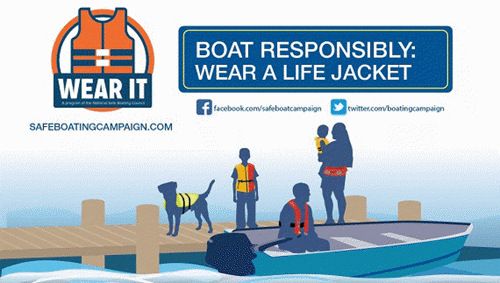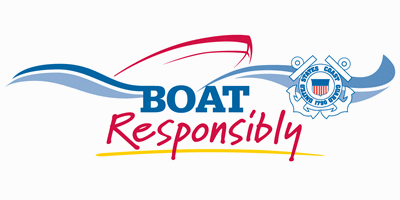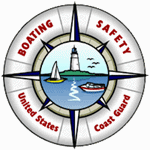Boat Responsibly
HOW TO ENSURE A SAFE BOATING SEASON!

As we head into prime boating season, The National Safe Boating Council’s Wear It campaign offers some important safety messages. Check out these stats from the U.S. Coast Guard’s 2016 Recreational Boating Statistics, the most recent report. The stats are a compilation of data from 50 states.
- 83% of boat drowning victims were not wearing a life jacket
- 77% of deaths occurred on boats where the operator had no boating safety instruction
- 15% of the deaths involved alcohol as the leading factor
- Two-thirds of drowning victims are good swimmers
- 4,463 boating accidents occurred, up 7.3% from the prior year
- 701 deaths occurred, up 12% from prior year
- 2,903 injuries, 11.1% increase
- $49 million dollars of property damage
One of the primary safety messages is Wear It: no matter what type of boating activity to you are involved in, wear a safety belt yourself and require all your passengers to wear one, too. It’s the single most effective safety measure you can take. For more on boating safety, download a copy of Boating Safety Tips from the National Safe Boating Council, which we’re reprinted below. We added some links to the tips, as well.
- Wear a life jacket. No matter what activity you have planned on the water, always remember to wear a life jacket every time you are on the water. Accidents on the water can happen much too fast to reach and put on a stowed life jacket. Life jacket types, fit and care.
- Make sure your life jacket is U.S. Coast Guard approved, appropriate for your water activity and fits properly. A life jacket that is too large or too small can cause different situational problems. How to choose the right life jacket (PDF).
- Know state boating laws. Rules and laws can differ from state to state and violations can result in ticketing, fines or jail time. State Boating Laws.
- Take a boating safety course. Learn valuable tips that can help save your life in unexpected situations by taking a NASBLA (National Association of Boating Law Administrators) approved boating safety course. Many courses are online, and will save you money on your boat insurance. US Coast Guard – Boating Safety Courses.
- Make sure your boat is prepared. There are many items that need to be check ed and rechecked on any boat. Schedule a Vessel Safety Check with your local U.S. Coast Guard Auxiliary or U.S. Power Squadrons before you hit the water. Every Vessel Safety Check is conducted 100 percent free of charge. U.S. Coast Guard’s Vessel Checks.
- Be sure to know your boat’s capacity. If you have too much on your boat, the boat may become unstable and capsize.
- Check the weather, including the water temperature. Know the latest marine weather forecast prior to going out, and keep a regular check for changing conditions. National Weather Service Marine Forecast.
- Dress properly. Always dress for the weather, wearing layers if cooler weather, and bring an extra set of clothes in case you get wet.
- Always file a float plan. File a float plan with someone you trust that includes details about the trip, boat, persons, towing or trailer vehicle, communication equipment and emergency contacts. Find out more and get resources at the Coast Guard’s Float Plan Central.
- Always follow navigation rules. Know the “Rules of the Road” such as operator’s responsibility, maintaining a proper lookout, safe speed, crossing, meeting head-on and overtaking situations. Know what’s going on around you at all times, and always travel at safe speeds for the environment. Find out more about navigation rules at Boat on Course from the National Safe Boating Council.
- Don’t drink while you boat. Where the primary cause was known, alcohol was listed as the leading factor in 15 percent of deaths in 2016. Find out more at Operation Dry Water from the National Association of State Boating Law Administrators.
- Beware of carbon monoxide poisoning. Gasoline-powered engines on boats, including onboard generators, produce carbon monoxide (CO), a colorless and odorless gas that can poison or kill someone who breathes too much of it. Be sure to install and maintain a working CO detector, never block exhaust outlets, and always dock, beach or anchor at least 20 feet away from the nearest boat that is running a generator or engine. Learn more at Prevent Carbon Monoxide Poisoning on Your Boat from the CDC.
- Keep in touch. Communication devices can be the most important piece of emergency equipment on board a vessel, especially in case of emergency. Be sure to have at least two communication devices that work when wet, such as satellite phones, emergency position indicating radio beacons (EPIRB), VHF radios and personal locator beacons (PLB). Cell phones are not reliable in an emergency situation.
More boating safety resources
- US Coast Guard Boating Safety Mobile App
- US Coast Guard’s Boating Safety Division
- National Association of Boating Law Administrators (NABLA)

The United States Coast Guard Office of Auxiliary and Boating Safety (CG-BSX) has a National Recreational Boating Safety (RBS) Program. The 2017-2021 Strategic Plan is published on the uscgboating.org webpage.
“Every year, more than 70 million Americans participate in recreational boating. Recreational boating has significant economic impacts and is an important part of the American heritage and culture…”
Key Facts
- Drowning was reported as the cause of death in 76% of all fatalities (four out of five people died from drowning).
- Approximately 84.5% of those who drowned were not wearing life jackets.
- In 2017, the Coast Guard counted 4,291 accidents that involved 658 deaths, 2,629 injuries and approximately $46 million dollars of damage to property as a result of recreational boating accidents.
- The fatality rate was 5.5 deaths per 100,000 registered recreational vessels. This rate represents a 6.8% decrease from the 2016 fatality rate of 5.9 deaths per 100,000 registered recreational vessels.
- Only 14% of deaths occurred on boats where the operator had received boating safety instruction.
- Operator inattention, improper lookout, operator inexperience, machinery failure and alcohol use as the top five primary contributing factors in accidents.
- Alcohol use is the leading known contributing factor in fatal boating accidents.
- Where the primary cause was known, alcohol was listed as the leading factor in 19% of deaths. Where data was known, the most common types of vessels involved in reported accidents were:
- Open motorboats (46%)
- Personal watercraft (18%)
- Cabin motorboats (16%)
Data Snapshot:
•Fatalities 658
•Drownings: 449
•Injuries (requiring medical treatment beyond first aid): 2,629
•Boating accidents: 4,291
•Property damage: $49,992,120.93
•Number of registered recreational boats in the U.S.: 11,961,568
All figures are from the U.S. Coast Guard’s 2017 Recreational Boating Safety Statistics, the latest official record of reported recreational boating accidents. Full report available: The U.S. Coast Guard Boating Safety Division.
 Let Your Family and friends know before you go!
REMEMBER to always complete a Float Plan before going on the
water!
To download a PDF Float Plan for completion, type USCG Float
Plan or visit this link:
http://floatplancentral.cgaux.org/download/USCGFloatPlan.pdf
Let Your Family and friends know before you go!
REMEMBER to always complete a Float Plan before going on the
water!
To download a PDF Float Plan for completion, type USCG Float
Plan or visit this link:
http://floatplancentral.cgaux.org/download/USCGFloatPlan.pdf